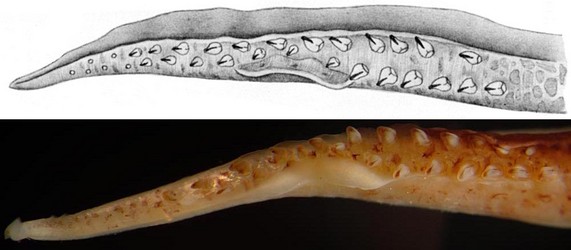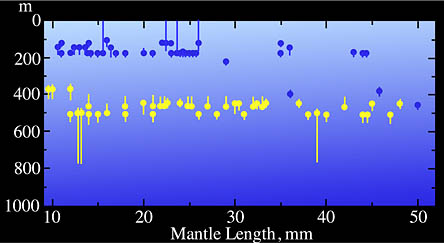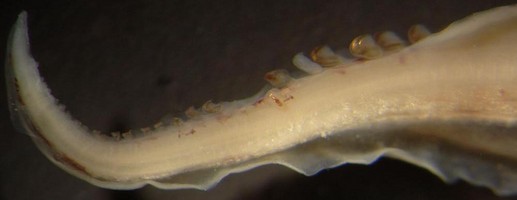Pyroteuthis addolux
Richard E. Young and Katharina M. Mangold (1922-2003)Introduction
This species is most easily separated from other members of the genus by the arrangement of photophores on the tentacles and the structure of the hectocotylus. It also appears to have shorter arms, relative to the mantle length, than in the other species.
Characteristics
- Head
- Beaks: Descriptions can be found here: Lower beak; upper beak.
- Beaks: Descriptions can be found here: Lower beak; upper beak.
- Tentacle-photophores
- Four large, ellipsoidal photophores (three are double photophores).
- Most distal member near base of carpal cluster (i.e., distance between this photophore and distal, spherical photophore much less than distance between distal two ellipsoidal photophores).
- Two smaller, spherical photophores, one at base of tentacular stalk and one at base of club.
- Spherical to ovoid superficial photophore (smallest of all) near base of tentacle and whose presence is variable.
- Four large, ellipsoidal photophores (three are double photophores).
- Hectocotylus (right arm IV) with:
- 10 proximal hooks.
- Each proximal hook small with primary cusp bearing smooth inner edge and short secondary cusp.
- Flap short, almost semicircular.
- 6-7 hooks opposite flap.
- 6-15 suckers at tip.
 Click on an image to view larger version & data in a new window
Click on an image to view larger version & data in a new window
Figure. Hectocotylus of P. addolux. Top - Oral view, holotype, 30 mm ML, off Southern California. Drawing from Young, 1972. Middle - Oral view, 25 mm ML, Hawaiian waters. Photograph by R. Young. Bottom - Side view of arm tip showing distal suckers, 25 mm ML, Hawaiian waters. Photograph by R. Young.
Comments
Compare the following structures with other species of Pyroteuthis:
Arm and tentacle armature is shown here. Characters of species value associated with these structures are not presently recognized except on the hectocotylus.
Life history
Paralarvae of this species are identified by:
- A series of chromatophores on the distal portion of each tentacle (see arrow in drawing). Unfortunately these are easily lost due to damage during capture.
- Small branchial photophores (smaller than the anal organs).
- Large ocular photophores.
- Few chromatophores on mantle.
Figure. Ventral view of P. addolux, 2.9 mm ML. Chromatophores - black; photophores - unfilled circles. Drawing modified from Young, et al., 1992.
Compare with paralarvae of Pterygioteuthis microlampas and Pterygioteuthis giardi.
Distribution
Vertical distribution
Off Hawaii, P. addolux is generally found at 450-500 m deep during the day and 150-200 m at night (Young, 1978). It shows a clear pattern of vertical migration although a few large squid taken in three tows during the same cruise failed to migrate at night.


Figure. Vertical distribution of P. addolux from Hawaiian waters based on an opening-closing trawl. Yellow dots - Day captures. Blue dots - Night captures. Vertical lines indicate vertical-fishing range of the tow and the symbol represents the modal fishing depth of the trawl. In some cases, the vertical lines are covered by the symbols. Chart redrawn from Young, 1978.
Geographical distribution
P. addolux was first described from off southern California (Young, 1972). It is also known from Hawaiian waters. This map shows the general localities (white circles) where P. addolux has been captured. Areas where pyroteuthids, other than members of this species, have been captured are represented by yellow crosses. (records listed here).

Geographical variation
The second photophore from the base of the tentacle (photophore number 2) is less common in squid from Hawaiian waters than in squid from Californian waters. Otherwise, geographical variation in taxonomic characteristics is unknown.
References
Young, R. E. 1972. The Systematics and Areal Distribution of Pelagic Cephalopods from the Seas off Southern California. Smithsonian Contribution to Zoology, 97: 1-159.
Young, R. E. 1978. Vertical distribution and photosensitive vesicles of pelagic cephalopods from Hawaiian waters. Fish. Bull., 76: 583-615.
Young, R. E., K. M. Mangold and M. Vecchione. 1992. The enoploteuthid group of families. P. 55-66. In: Sweeney, M. J., C. F. E. Roper, K. M. Mangold, M. R. Clarke and S. V. Boletzky (Eds.). "Larval" and juvenile cephalopods: A manual for their identification. Smithson. Contr. Zool. No. 513
Title Illustrations

| Scientific Name | Pyroteuthis addolux |
|---|---|
| Location | off Hawaii |
| Image Use |
 This media file is licensed under the Creative Commons Attribution-NonCommercial License - Version 3.0. This media file is licensed under the Creative Commons Attribution-NonCommercial License - Version 3.0.
|
| Copyright |
© 1996

|
About This Page

University of Hawaii, Honolulu, HI, USA
Katharina M. Mangold (1922-2003)

Laboratoire Arago, Banyuls-Sur-Mer, France
Page copyright © 2016 and Katharina M. Mangold (1922-2003)
 Page: Tree of Life
Pyroteuthis addolux .
Authored by
Richard E. Young and Katharina M. Mangold (1922-2003).
The TEXT of this page is licensed under the
Creative Commons Attribution-NonCommercial License - Version 3.0. Note that images and other media
featured on this page are each governed by their own license, and they may or may not be available
for reuse. Click on an image or a media link to access the media data window, which provides the
relevant licensing information. For the general terms and conditions of ToL material reuse and
redistribution, please see the Tree of Life Copyright
Policies.
Page: Tree of Life
Pyroteuthis addolux .
Authored by
Richard E. Young and Katharina M. Mangold (1922-2003).
The TEXT of this page is licensed under the
Creative Commons Attribution-NonCommercial License - Version 3.0. Note that images and other media
featured on this page are each governed by their own license, and they may or may not be available
for reuse. Click on an image or a media link to access the media data window, which provides the
relevant licensing information. For the general terms and conditions of ToL material reuse and
redistribution, please see the Tree of Life Copyright
Policies.
- Content changed 16 November 2016
Citing this page:
Young, Richard E. and Katharina M. Mangold (1922-2003). 2016. Pyroteuthis addolux . Version 16 November 2016 (under construction). http://tolweb.org/Pyroteuthis_addolux/19757/2016.11.16 in The Tree of Life Web Project, http://tolweb.org/











 Go to quick links
Go to quick search
Go to navigation for this section of the ToL site
Go to detailed links for the ToL site
Go to quick links
Go to quick search
Go to navigation for this section of the ToL site
Go to detailed links for the ToL site